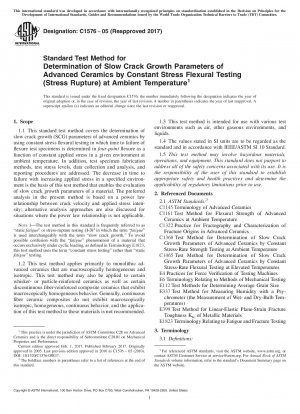ASTM C1576-05(2017)
Standard Test Method for Determination of Slow Crack Growth Parameters of Advanced Ceramics by Constant Stress Flexural Testing (Stress Rupture) at Ambient Temperature
- Standard No.
- ASTM C1576-05(2017)
- Release Date
- 2005
- Published By
- American Society for Testing and Materials (ASTM)
- Latest
- ASTM C1576-05(2017)
- Scope
4.1 The service life of many structural ceramic components is often limited by the subcritical growth of cracks. This test method provides an approach for appraising the relative slow crack growth susceptibility of ceramic materials under specified environments at ambient temperature. Furthermore, this test method may establish the influences of processing variables and composition on slow crack growth as well as on strength behavior of newly developed or existing materials, thus allowing tailoring and optimizing material processing for further modification. In summary, this test method may be used for material development, quality control, characterization, design code or model verification, and limited design data generation purposes.
Note 4: Data generated by this test method do not necessarily correspond to crack velocities that may be encountered in service conditions. The use of data generated by this test method for design purposes, depending on the range and magnitude of applied stresses used, may entail extrapolation and uncertainty.
4.2 This test method is related to Test Method C1368 (“constant stress-rate flexural testing”), however, C1368 uses constant stress rates to determine corresponding flexural strengths whereas this test method employs constant stress to determine corresponding times to failure. In general, the data generated by this test method may be more representative of actual service conditions as compared with those by constant stress-rate testing. However, in terms of test time, constant stress testing is inherently and significantly more time consuming than constant stress rate testing.
4.3 The flexural stress computation in this test method is based on simple elastic beam theory, with the assumptions that the material is isotropic and homogeneous, the moduli of elasticity in tension and compression are identical, and the material is linearly elastic. The grain size should be no greater than one-fiftieth (1/50 ) of the beam depth as measured by the mean linear intercept method (Test Methods E112). In cases where the material grain size is bimodal or the grain size distribution is wide, the limit should apply to the larger grains.
4.4 The test specimen sizes and test fixtures have been selected in accordance with Test Methods C1161 and C1368, which provides a balance between practical configurations and resulting errors, as discussed in Ref (4, 5).
4.5 The data are evaluated by regression of log applied stress versus log time to failure to the experimental data. The recommendation is to determine the slow crack growth parameters by applying the power law crack velocity function. For derivation of this, and for alternative crack velocity functions, see Appendix X1.
Note 5:
ASTM C1576-05(2017) Referenced Document
- ASTM C1145 Standard Terminology of Advanced Ceramics
- ASTM C1161 Standard Test Method for Flexural Strength of Advanced Ceramics at Ambient Temperature
- ASTM C1322 Standard Practice for Fractography and Characterization of Fracture Origins in Advanced Ceramics
- ASTM C1368 Standard Test Method for Determination of Slow Crack Growth Parameters of Advanced Ceramics by Constant Stress Rate Strength Testing at Ambient Temperature
- ASTM C1465 Standard Test Method for Determination of Slow Crack Growth Parameters of Advanced Ceramics by Constant Stress-Rate Flexural Testing at Elevated Temperatures
- ASTM E112 Standard Test Methods for Determining Average Grain Size
- ASTM E1823 Standard Terminology Relating to Fatigue and Fracture Testing
- ASTM E337 Standard Test Method for Measuring Humidity with a Psychrometer (the Measurement of Wet- and Dry-Bulb Temperatures)
- ASTM E399 Standard Test Method for Plane-Strain Fracture Toughness of Metallic Materials
- ASTM E4 Standard Practices for Force Verification of Testing Machines
- ASTM E6 Standard Terminology Relating to Methods of Mechanical Testing
ASTM C1576-05(2017) history
- 2005 ASTM C1576-05(2017) Standard Test Method for Determination of Slow Crack Growth Parameters of Advanced Ceramics by Constant Stress Flexural Testing (Stress Rupture) at Ambient Temperature
- 2005 ASTM C1576-05(2010) Standard Test Method for Determination of Slow Crack Growth Parameters of Advanced Ceramics by Constant Stress Flexural Testing (Stress Rupture) at Ambient Temperature
- 2005 ASTM C1576-05 Standard Test Method for Determination of Slow Crack Growth Parameters of Advanced Ceramics by Constant Stress Flexural Testing (Stress Rupture) at Ambient Temperature

Copyright ©2024 All Rights Reserved